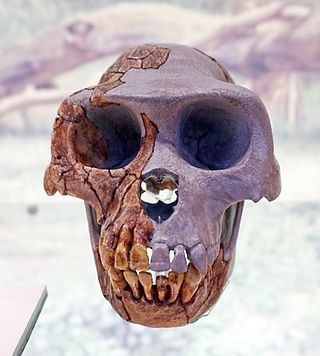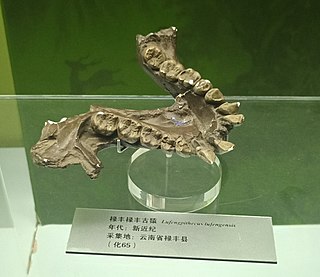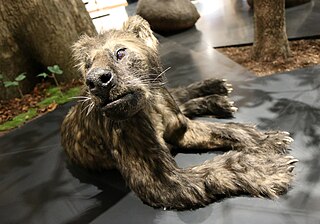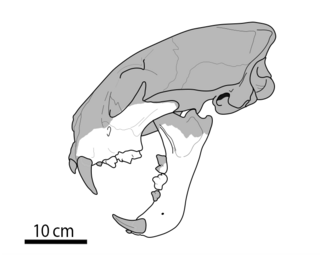
Orrorin is an extinct genus of primate within Homininae from the Miocene Lukeino Formation and Pliocene Mabaget Formation, both of Kenya.

Meganthropus is an extinct genus of non-hominin hominid ape, known from the Pleistocene of Indonesia. It is known from a series of large jaw and skull fragments found at the Sangiran site near Surakarta in Central Java, Indonesia, alongside several isolated teeth. The genus has a long and convoluted taxonomic history. The original fossils were ascribed to a new species, Meganthropus palaeojavanicus, and for a long time was considered invalid, with the genus name being used as an informal name for the fossils.

Pierolapithecus catalaunicus is an extinct species of primate which lived around 12.5-13 million years ago during the Miocene in what is now Hostalets de Pierola, Catalonia, Spain. Some researchers believe that it is a candidate for common ancestor to the great ape clade, or is at least closer than any previous fossil discovery. Others suggest it being a pongine, or a dryopith. On 16 October 2023, scientists reported the facial reconstruction of the great ape.

Aegyptopithecus is an early fossil catarrhine that predates the divergence between hominoids (apes) and cercopithecids. It is known from a single species, Aegyptopithecus zeuxis, which lived around 38-29.5 million years ago in the early part of the Oligocene epoch. It likely resembled modern-day New World monkeys, and was about the same size as a modern howler monkey, which is about 56 to 92 cm long. Aegyptopithecus fossils have been found in the Jebel Qatrani Formation of modern-day Egypt. Aegyptopithecus is believed to be a stem-catarrhine, a crucial link between Eocene and Miocene fossils.

Victoriapithecus macinnesi was a primate from the middle Miocene that lived approximately 15 to 17 million years ago in Northern and Eastern Africa. Through extensive field work on Maboko Island in Lake Victoria, Kenya, over 3,500 specimens have been found, making V. macinnesi one of the best-known fossil primates. It was previously thought that perhaps multiple species of Victoriapithecus were found, however the majority of fossils found indicate there is only one species, V. macinnesi. Victoriapithecus shows similarities to the extant subfamilies Colobinae and Cercopithecinae. However, Victoriapithecus predates the last common ancestor of these two groups and instead is thought to be a sister taxon.

Amphicyon is an extinct genus of large carnivorans belonging to the family Amphicyonidae, subfamily Amphicyoninae, from the Miocene epoch. Members of this family received their vernacular name for possessing bear-like and dog-like features. They ranged over North America, Europe, Asia, and Africa.

Wakaleo is an extinct genus of medium-sized thylacoleonids that lived in Australia in the Late Oligocene and Miocene Epochs. Although much smaller than its close relative, the marsupial lion, Wakaleo would have been a successful hunter. It had teeth specially designed for cutting and stabbing. The genus is from an extinct family of Vombatiformes, so it is distantly related to the herbivorous wombats.

Nakalipithecus nakayamai, sometimes referred to as the Nakali ape, is an extinct species of great ape from Nakali, Kenya, from about 9.9–9.8 million years ago during the Late Miocene. It is known from a right jawbone with 3 molars and from 11 isolated teeth. The jawbone specimen is presumed female as the teeth are similar in size to those of female gorillas and orangutans. Compared to other great apes, the canines are short, the enamel is thin, and the molars are flatter. Nakalipithecus seems to have inhabited a sclerophyllous woodland environment.

Ardipithecus ramidus is a species of australopithecine from the Afar region of Early Pliocene Ethiopia 4.4 million years ago (mya). A. ramidus, unlike modern hominids, has adaptations for both walking on two legs (bipedality) and life in the trees (arboreality). However, it would not have been as efficient at bipedality as humans, nor at arboreality as non-human great apes. Its discovery, along with Miocene apes, has reworked academic understanding of the chimpanzee–human last common ancestor from appearing much like modern-day chimpanzees, orangutans and gorillas to being a creature without a modern anatomical cognate.

Lufengpithecus is an extinct genus of ape, known from the Late Miocene of East Asia. It is known from thousands of dental remains and a few skulls and probably weighed about 50 kg (110 lb). It contains three species: L. lufengensis, L. hudienensis and L. keiyuanensis. Lufengpithecus lufengensis is from the Late Miocene found in China, named after the Lufeng site and dated around 6.2 Ma. Lufengpithecus is either thought to be the sister group to Ponginae, or the sister to the clade containing Ponginae and Homininae.

Agnotherium is a genus of large sized carnivoran mammals, belonging to the Amphicyonidae, which has been found in Western Europe, and possibly China and Northern Africa, and lived during the Late Miocene epoch. Despite only being known from fragmentary remains, the genus notable for hypercarnivorous adaptions, which have been said to represent the "apex" among its family.

Ysengrinia is an extinct genus of carnivoran in the family Amphicyonidae (beardogs), which lived in Europe, Asia, and North America during the Early Miocene. It was also reported from Egypt and Namibia, but this material has been reassigned to other genera of beardogs.

Graecopithecus is an extinct genus of hominid that lived in southeast Europe during the late Miocene around 7.2 million years ago. Originally identified by a single lower jaw bone bearing teeth found in Pyrgos Vasilissis, Athens, Greece, in 1944, other teeth were discovered from Azmaka quarry in Bulgaria in 2012. With only little and badly preserved materials to reveal its nature, it is considered as "the most poorly known European Miocene hominoids." The creature was popularly nicknamed 'El Graeco' by scientists.

Ouranopithecus macedoniensis is a prehistoric species of Ouranopithecus from the Late Miocene of Greece. See more detail at Ouranopithecus.
Globidentosuchus is an extinct genus of basal caimanine crocodylian known from the late Middle to Late Miocene of the Middle and the Upper Members of the Urumaco Formation at Urumaco, Venezuela. Its skull was very short and robust, with large units of spherical teeth used to break the shells of molluscs as part of its durophagus diet. It is thought to be one of the most basal Caimanines, even sharing some traits with alligatorids.

Acropyga glaesaria is an extinct species of ant in the subfamily Formicinae known from a group of possibly Miocene fossils found on Hispaniola. A. glaesaria is the first species of the ant genus Acropyga to have been described from fossils found in Dominican amber and is the one of several species of Acropyga found in the West Indies. As with other members of the genus, A. glaesaria was most likely trophobiotic.

Spheniscus muizoni is an extinct species of banded penguins that lived during the early Late Miocene in what is now Peru, South America. The species, the earliest member of the extant genus, was described in 2007 by Ursula B. Göhlich based on fossils found in the fossiliferous Pisco Formation of the Pisco Basin, southwestern Peru.
Danuvius guggenmosi was an extinct species of great ape that lived 11.6 million years ago during the Middle–Late Miocene in southern Germany. It is the sole member of the genus Danuvius. The area at this time was probably a woodland with a seasonal climate. A male specimen was estimated to have weighed about 31 kg (68 lb), and two females 17 and 19 kg. Both genus and species were described in November 2019.
Micropithecus is an extinct genus of primates that lived in East Africa about 19 to 15 million years ago, during the early Miocene. The genus and its type species, Micropithecus clarki, were first scientifically described in 1978.

Pachypanthera is an extinct genus of pantherine felid that was recovered from the Late Miocene-aged Khorat sand pits in northeastern Thailand. It contains a single species, Pachypanthera piriyai, named and described in 2023.
















